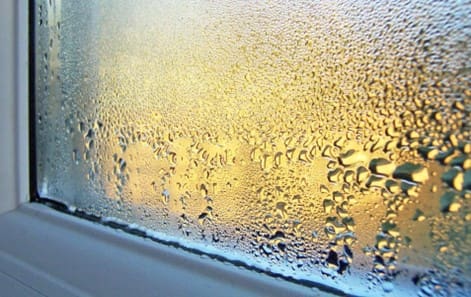What is Condensation?
Condensation on windows occurs because water vapor in the air deposits itself on surfaces that are at a lower temperature. When that moist air comes into contact with the cold impermeable glass surface of your windows, it releases some of this moisture onto the glass as water droplets. This is condensation. A small amount of condensation on windows during cold weather is usually normal however large amounts of condensation can indicate poor ventilation, high indoor humidity or issues with inadequate insulation in your home.
How to Manage Condensation
Humidity in the Home: To understand the issues of humidity in the home let’s begin by understanding where air moisture comes from. A typical family of four can add about half a pint of water to the air every hour through normal perspiration and breathing. Cooking three meals a day can add four or five pints of water to the air as does dishwashing, cleaning floors and doing laundry. Each shower a member of the family takes adds another half-pint of humidity. Through daily activities, household chores and personal care a family of four can contribute a total of 18 gallons of water a week to the air of their home. Household plants and the burning of fossil fuels like natural gas also add to household humidity.
Some humidity in the home is beneficial to both the home itself, furnishings of the home and the occupants of the home. Humidity levels between 30% and 50% can be beneficial. Levels higher than 65% however can cause upper respiratory illnesses. Levels lower that 20% can cause skin dryness and itching.
Management of Humidity: Several steps can be made to provide a healthy level of humidity in your home for both the occupants of the home and the home itself. These steps include:
- When possible open the windows slightly to allow air circulation in rooms with high moisture like kitchens and bathrooms. Use fans in the shower and bathroom area to remove steam and moisture as soon as it is created.
- Use a dehumidifier to lower indoor humidity levels particularly in the hot humid months of summer.
- Maintain a consistent, moderate temperature in the home.
- Check for drafts around windows and other areas where weather-stripping is used.
- Be sure that all gas appliances, clothes dryers and exhaust fans are properly vented to the outside. The crawl space of the attic should also be ventilated.
- When cooking run the exhaust fans to remove excess steam.
- Move furniture away from external walls of the home to allow proper airflow.
- Avoid over filling wardrobes, closets and cupboards. A lack of airflow in these areas can create a breeding ground for mold and mildew.
- Repair any leaks promptly. Check pipes, roofs and walls.
- Avoid running humidifiers at to high of a level.
Can Specific Windows and Window Treatments Cause Higher Levels of Condensation?
Bay or bow windows often experience more condensation than other types of windows. These types of windows typically hang away from the insulated house wall resulting in a greater variance of temperature. Bay and bow windows can benefit from adding more insulation to both the head and platform of the window. The addition of an electric fan near the window also helps promote air circulation thus reducing window condensation.
Drapes and window treatments that are closed can also restrict the flow of air over the glass surface adding to issues resulting in window condensation.
What Causes Moisture to Form on the Outside of the Window?
This is often referred to as “dew”. This type of condensation occurs only when the exterior surface temperature of the glass falls below the dew point of the air. This typically happens in the spring and fall when days are warm and nights are cool.
Can Condensation Damage Windows or Your Home?
While the condensation itself is not a problem, not treating what is causing it can be over time. Excess condensation can cause paint to peel on sashes and left untreated can cause the window frame to rot. It is important to remember that if excess humidity is causing windows condensation, it may be creating other issues throughout your home. Questions you need to ask yourself:
- Does your home have a “damp” feeling?
- Are there stains or discoloration on surfaces of your home?
- Does your home have a “musty smell”? If so, mold or mildew may be accumulating on surfaces.
- Are wood surfaces warped?
- Are pipes in the home “sweating”?
- Are painted surfaces on the interior or exterior of the home cracking, peeling or blistering?
Can Condensation be a Temporary Concern?
Window condensation can be a temporary issue when:
- In new construction and remodeling: wood, plaster, cement and other building materials used releases the moisture from those products into the air. Typically, the issue of condensation will disappear during the first heating season and not cause further problems.
- At the beginning of the heating season temporary condensation may occur. Again, this will disappear after a few weeks of heating.
- Sharp drops in temperature can also create condensation issues during a heating season.
Maximum Recommended Humidity Levels
Outside Air Temperature Inside Relative Humidity
-20 F or Below Not over 15%
-20 F to – 10 F Not over 20%
-10 F to 0 F Not over 25%
0 F to 10 F Not over 30%
10 F to 20 F Not over 35%
20 F to 40 F Not over 40%



